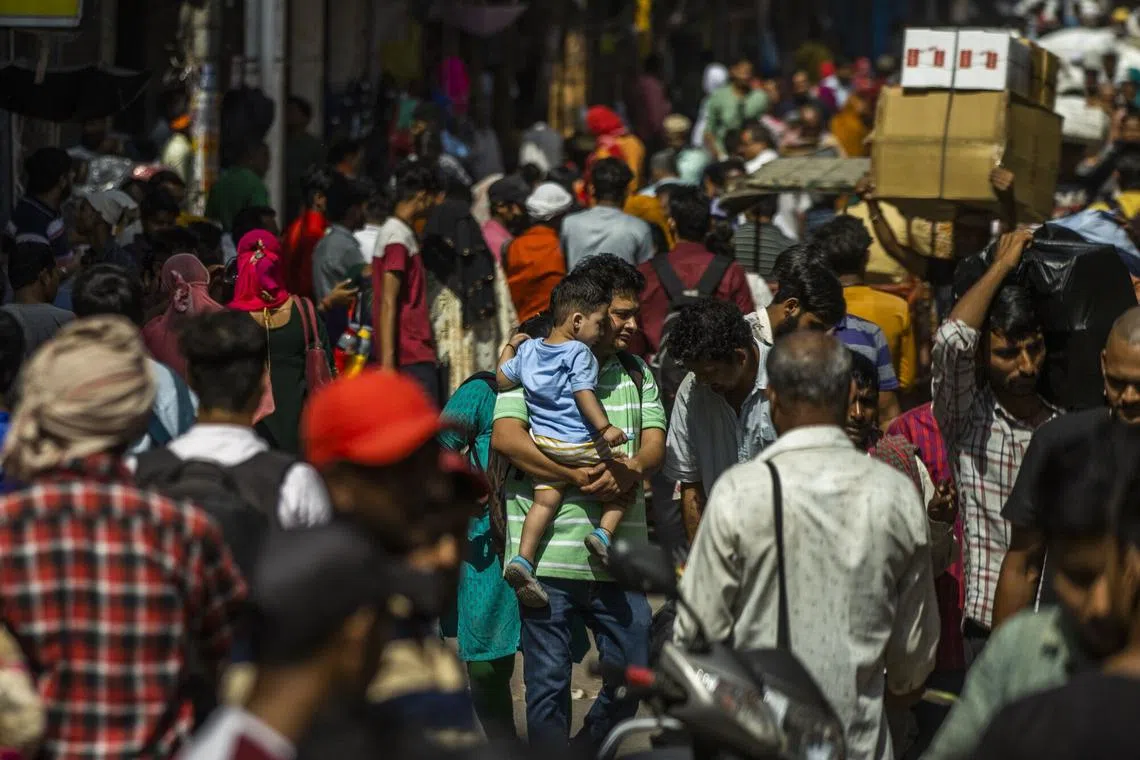What becoming the world’s most populous nation means for India
Sign up now: Get insights on Asia's fast-moving developments

India is now home to nearly a fifth of humanity, with over 1.4 billion people.
PHOTO: BLOOMBERG
Follow topic:
NEW DELHI – India will soon overtake China as the most populous country
With roughly 2.4 per cent of the world’s land mass, India is now home to nearly a fifth of humanity – over 1.4 billion people, or more than the entire population of the Americas, or Africa, or Europe.
Of course, such comparisons still ring true for China, which is also roughly three times India’s size. But India’s population is relatively young and growing, while China’s is ageing and shrinking.
Such demographic shifts pose major economic and social challenges for the Asian giants as they struggle to adapt.
1. How is India’s population counted?
According to mid-2023 estimates by the UN, India’s population surpassed 1.4286 billion, slightly higher than China’s 1.4257 billion people.
The last census was completed in 2011, and Prime Minister Narendra Modi’s government deferred the once-a-decade exercise in 2021, citing pandemic disruptions. There has been no indication when the vast, complicated effort to count the South Asian nation’s inhabitants will resume.
So current data is based on estimates and projections. India added about 23 million babies in 2022, though its birth rate – the number of live births per 1,000 population – has slowed, to 19.7 in 2019, from 24.1 in 2004.
The country’s population continues to grow, albeit at a slower pace.
In 2022, China registered only about 9.56 million newborns – the lowest since at least 1950
India’s population is predicted to continue on an upward trend until it peaks in the early to mid-2060s, while the forecast for China is a steady headcount decline.
2. What are the pros and cons of a burgeoning population for India?
Not only does India have more people, it also has one of the youngest populations, UN data shows. More than half its population is under the age of 30, with a median age of 28. That compares with about 38 in both the United States and in China.
This youth advantage could play a critical role in unlocking economic growth. With over two-thirds of its people of working age – between 15 and 64 years old – India could both produce and consume more goods and services, drive innovation, and keep pace with constant technological changes.
That is if it is able to deliver the vast number of jobs it needs as it transitions to an industrialised economy and people move off the farm.
Mr Modi, who is expected to seek a third term in 2024, has been pushing to improve the share of manufacturing in the economy to 25 per cent, from the 14 per cent it is currently stuck at.
3. Can India cope?
India faces many challenges: It needs to effectively address core problems of poverty, hunger and malnutrition, provide better health and education, build infrastructure, and make villages and towns liveable.
Climate change is making it harder to deliver food security – and electricity – across the still largely agrarian nation. Prolonged heatwaves in recent years have caused widespread suffering and strained power supplies.
The country also is facing acute water problems, including shortages and pollution. About 40 per cent of rural households do not have running water indoors.
Federal and state government spending on healthcare is around 2 per cent of gross domestic product, among the lowest in the world. More than one-third of children below five years old are stunted, and half of women in the age group between 15 and 49 years are anaemic.
The country ranked last out of 180 countries in the Environmental Performance Index 2022 released by Yale University.
Close to a third of the nation’s youth are not in any employment, education or training. Only 5 per cent of the country’s workforce are recognised as formally skilled, and the country’s schools and universities have poor infrastructure and lack qualified teachers.
5. What about population control?
In the 1970s, India’s government began to seriously promote smaller families. A Hindi slogan, “hum do, humare do”, loosely translating to “the two of us and our two children” – first coined in the 1950s – became ubiquitous in ads on state-run TV and radio stations, and across newspapers and magazines.
Female sterilisation, male vasectomies and contraception were all made cheaply or freely available through government-run hospitals and clinics. In recent years, that programme has petered out, but it may have had an effect.
Fertility rates had already begun to trend lower in the 1960s, World Bank data shows, and has now dropped to two, just below the replacement level of fertility of 2.1 children per woman, according to government data.
The UN-projected India will have a population of 1.668 billion by 2050. China has gone back and forth over the years as it shifted from trying to limit births to encouraging more, fearing the economic repercussions of a shrinking workforce. The UN earlier predicted China will have 1.317 billion people by 2050.
6. What does being No. 1 mean for India politically?
Aside from bragging rights, the country’s new status as not only the world’s biggest democracy, but also the most populous, could bolster its claim for a permanent seat in the UN Security Council. (Only five countries have the status now – the US, United Kingdom, France, Russia and China.)
India is already using its growing market power to position itself as a significant geopolitical player – building close relations with the US, Japan and Australia in the Quad grouping – but also charting a contrary foreign policy.
It has held back against joining global sanctions against Russia over its invasion of Ukraine and continued to snap up cheap Russian crude. BLOOMBERG

